Fancy Colored Diamond Grading Scale And Charts
The ideal, utopist diamond is a bunch of pure carbon atoms aligned in a crystal lattice. However, this only appears in chemistry textbooks or in sterile laboratories – and never in the feature stones of engagement rings that were formed naturally.
During a diamond’s formation, natural occurring elements like nitrogen, boron or aluminum can enter the diamond’s crystal lattice. This distortion of the lattice is responsible for the color appearance of the stone and is largely dependent on the composition of specific trace elements.
Diamonds are graded based on a system of 4Cs that was created by GIA. Color is one of the elements that makes up a key component in a diamond’s value. In white or colorless diamonds, the absence of color drives the value of the stone upwards due to relative rarity in nature. Hence, when we are talking about the normal color range of diamonds, less is actually more!
The GIA Color Grading Scale And Chart Illustration

When we delve into the other end of the spectrum, any diamond that lies out of the scale is graded as a fancy colored diamond (FCD). Here’s also where things work in a totally different manner. Instead of assigning a diamond’s color as a single alphabet like D or J, fancy colored diamonds are described with words based on its hue.
Understanding Hue And Its Importance
Below is an illustration to help you understand the concept if hue. In essence, there are 27 main descriptions of hues used in GIA’s system. These include green, pink, blue as well as mixed combinations like greenish yellow or purplish pink.
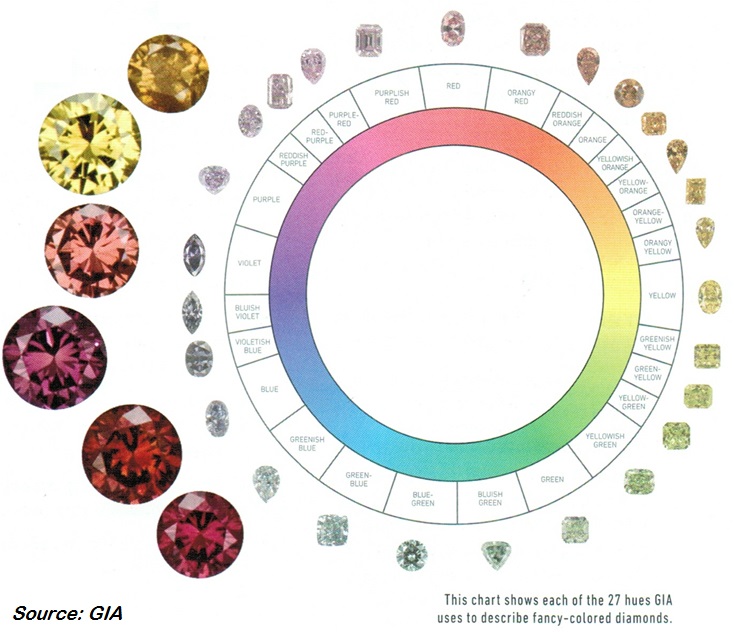
Here Are 4 Real Life Examples
As you might have guessed, the value of a fancy colored diamond is actually dependent on the hue it possess. In this case, the rarer the hue, the more valuable the diamond becomes! For example, pink coloration is extremely rare in nature while brown is the most common fancy diamond color. Needless to say, price differences between such stones can be as high as a 100 times!
Take note that the predominant color is always stated last. For example, if GIA describes a diamond as fancy purplish pink, the dominant color is PINK and not purple.
Terms Used to Describe Intensity/Saturation
Apart from hue, there are two other characteristics which are used to describe the exact color of a given stone. These are tone and saturation. Tone refers to the relative lightness or darkness of a color. Saturation refers to the strength of the color.
The GIA differentiates nine levels of saturation. These are, in increasing order “faint”, “very light”, “light”, “fancy light”, “fancy”, “fancy intense”, “fancy dark”, “fancy deep” and “fancy vivid”. Some hues can exist in all of the nine saturation levels, but some of them are might not follow the same rules. For example, orange diamonds are not found in the first six saturation levels and only exists as fancy dark, fancy deep or fancy vivid. Likewise, blue diamonds typically do not occur in such a wide range of levels too.
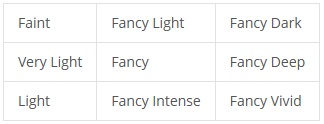
Let’s visualize with some examples to help you get a better understanding of the face up view of various intensities.
Broadly speaking, the stronger the hue of a diamond, the more valuable and desirable the stone is. This means that an accurate grading of the diamond is paramount to helping shoppers gauge the value of the stone. For this reason, I only recommend GIA reports. You should NEVER buy colored diamonds without certifications and you should avoid reports from labs like EGL or IGI who are well known for their lax standards.
Leave A Comment

 – 1.39 Carat Trillion Cut
– 1.39 Carat Trillion Cut – 0.42 Carat Trillion Cut
– 0.42 Carat Trillion Cut – 0.53 Carat Cushion Cut
– 0.53 Carat Cushion Cut – 0.55 Carat Radiant Cut
– 0.55 Carat Radiant Cut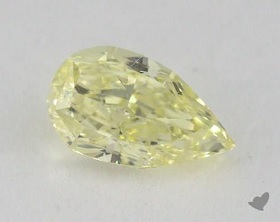
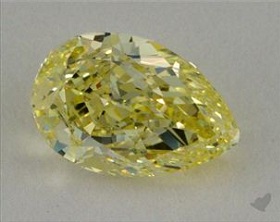
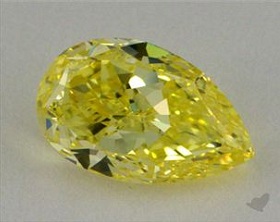
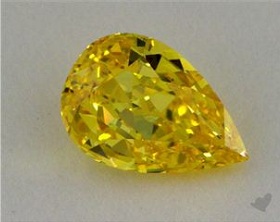
2 Comments
thanks
The pictures seen of diamonds is so beautiful and had seen the cost for very first time and hope to work if I could get a chance so that I may have a chance to see in my hand a real diamond how’s it feel like.